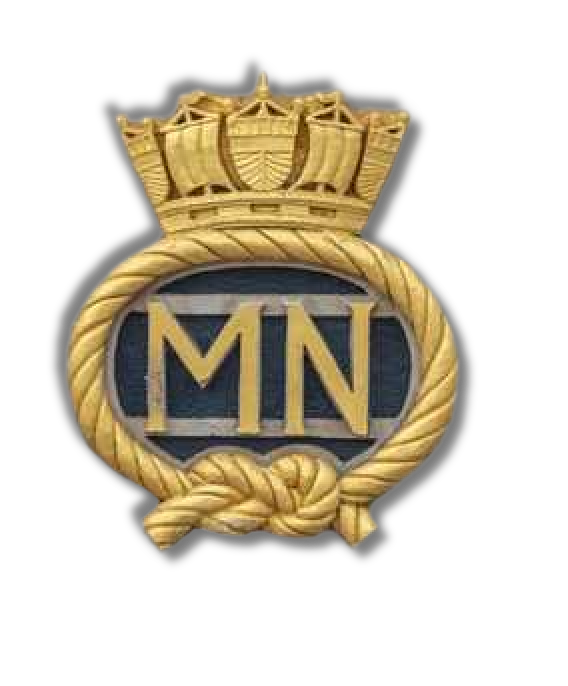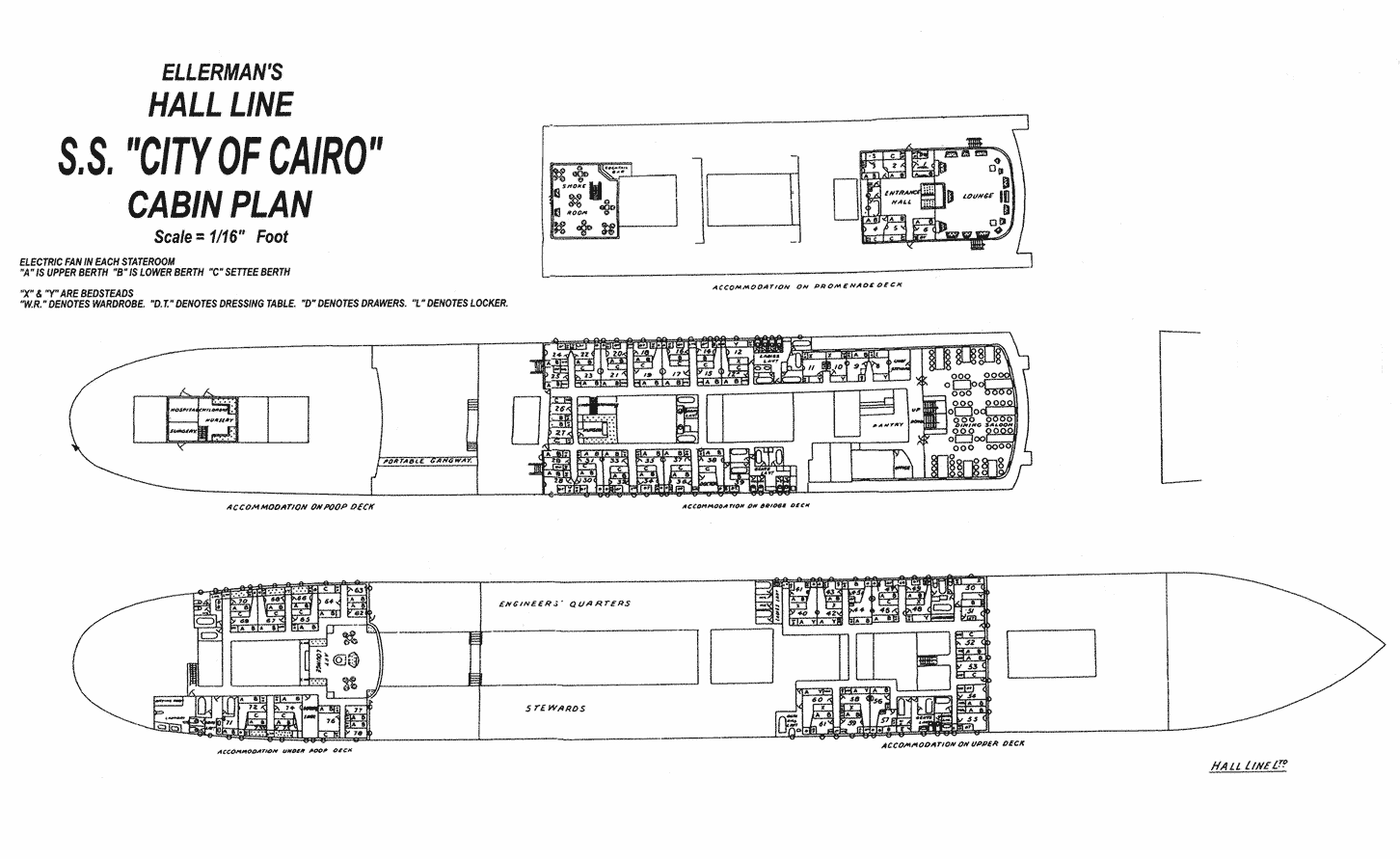No.1 Boat Log
The National Archives, Kew, ADM199/2143. I have not altered the text in any way.
ss CITY OF CAIRO - 6.263 Gross Tons. Independent
10th March, 1943.
Shipping Casualties Section - Trade Division.
Report of an interview with the 3rd Steward and Ship's
Writer Mr. J.C. Edmead
Sunk by two torpedoes from U-Boat
on 6th November 1942.
All times in G.M.T.
Mr. J.C. Edmead
We sailed from Cape Town bound for Pernambuco with a cargo of 10,000 tons of General Stores. The ship was armed with one 12 pounder, two Twin Marlins, two Twin Hotchkiss, two Oerlikons and four P.A.C Rockets. The crew numbered about 197, including 7 Naval and 4 Military Gunners. We also had on board 136 passengers, including 9 Officers of the Navy, Army and Merchant Navy, and 18 children. I do not know the number of casualties but 52 out of the crew of my lifeboat died. All the Confidential Books and Wireless Books were kept in weighted boxes, I did not see them thrown overboard but presume they went down with the ship. Degaussing was off.
2. We sailed from Cape Town on the 1st November at 0930, proceeding independently as routed by the N.C.S.O. for Pernambuco. On the 3rd November we intercepted a message about submarines being in the vicinity but as we received no diversion signals we continued on our course.
3. At 2030 on the 6th November, in position 23.30S. - 5.30W. whilst steaming at 12 knots, we were struck by a torpedo. The weather was fine, it was a clear starlit night with no moon, and visibility was very good. There was a slight sea and swell with light variable airs.
4. The first torpedo struck the ship in No.4 deep tank on the port side with a heavy dull explosion. A column of water was thrown up but no flash of flame was seen. All electricity failed, the accommodation aft was wrecked, but the main engines remained undamaged. The ship listed slightly to port but quickly righted herself. We carried nine lifeboats which the Captain ordered to be lowered. While the crew were lowering the boats I went forward with the 2nd Engineer and released four rafts. All the lifeboats were lowered safely alongside the ship, and most of the crew were away, when at 2040 a second torpedo struck the ship amidships again on the port side. This was a loud explosion, a large column of water was thrown up, and there was a brilliant flash. All the accommodation amidships was shattered, two of the lifeboats in the water on the port side were capsized and a third one was badly damaged.
5. I was in one of the lifeboats which was capsized by the explosion from the second torpedo. Whilst in the water I sighted a raft a short distance away. At 2050, before swimming towards it I turned and saw the ship sinking very quickly stern first and as she disappeared I swam to the raft and climbed on board. During the next hour, 20 more of the crew found their way to this raft and at daybreak there were 24 men on it. I heard the Captain shouting to the lifeboat to tie up together for the night and put out their sea anchors.
6. At daybreak on the 7th November the Captain called a muster; it was found that 3 passengers and a Wireless Operator were missing. I then heard that the 2nd Wireless Operator had transmitted an S.O.S. message and had received an acknowledgement from Cape Town before the ship sank. When it became light I, accompanied by several of the crew, swam to the capsized lifeboats. We succeeded in righting one of those boats, but on bailing it out we found it was leaking badly through one or two of the seams. I cut a hole in my lifejacket, pulled out some kapok, plugging this with some white lead into the seams. Finally, 54 of us managed to get into this lifeboat with the Chief Officer in charge.
7. During the morning we collected all the food, water and gear from the four rafts, dividing it amongst the other lifeboats. The Captain ordered all the boats to set sail and steer N.N.E. keeping together during daylight and tying up in line ahead at night. As our boat was still making water it was necessary to maintain 2 hour pumping watches, day and night, to prevent the boat from becoming waterlogged. On the 8th November the Chief Officer asked permission from the Captain to leave the other boats and proceed to St. Helena as our boat was the fastest sailer. The Captain was reluctant to agree, but on the following day, realizing that our boat could indeed sail a great deal faster than the others, he agreed to let us sail for St. Helena, which we estimated to be about 220 miles distant. The Chief Officer reckoned that we could make this island in about 12 days.
8. Accordingly, on the evening of the 9th November our boat left the other six and continued independently. There were 54 men in the boat, 11 crew, including a Doctor, a Captain, Royal Navy, and one woman. The Chief Officer took charge of the lifeboat, ably assisted by Captain MacCall, Royal Navy, and we sailed through very fine weather with slight seas for about 9 days without incident.
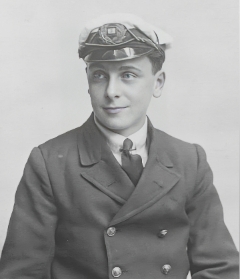
Courtesy of Tom Miller-McCall
Capt. Thomas D. McCall
9. The Chief Officer rationed the food and water, allowing 3 meals a day, each meal consisted of 4 oz, of water, biscuits, pemmican, chocolate and horlicks tablets. There was plenty of food with more than 30 gallons of water in the lifeboat, and it was estimated that with these rations we could exist for about 3 months. After about the 10th day, as land was not sighted the natives grew very low spirited, becoming unwilling to assist in bailing the boat, consequently the Europeans had to do twice as much work. Some of the natives began to drink salt water about this time, which made them more thirsty, and from the 10th day onwards several natives were delirious. From noon until 1800 each day the sun beat down on us unmercifully and it was impossible to keep cool. An old flag was torn up, each man was given a small piece to put over his head. On the 11th day the first native died, and during the next few days they died, two and three at a time. It was about this time that some of the Europeans began to lose heart, several of them dying at various intervals. Death in each case appeared to follow an attack of delirium lasting about 3 hours. From this time onwards the crew gradually lost their appetites and the water situation became very grave. On the 14th day the Chief Officer died, so Captain MacCall R.N. took charge and carried on with the steering. Some of the men gargled with salt water while others used a solution of iodine and salt water, but after the 15th day several of them suffered from acute soar throats. One of the Quartermasters developed a high fever which lasted for three days before he died; just about this time Captain MacCall died during the 16th day. The men now died on various days until on the 28th day there were only 6 of us left, the water had practically given out and there was only one more ration remaining for each. We were all feeling very tired and disinclined to work but the boat had to be bailed out morning and night in order to keep her afloat. During the evening of the 29th day we experienced a heavy rain storm. We all drank as m much water as we could then caught some rain in the jib, finally collecting about ¾ of a gallon which was put into one of the empty water breakers. Three more of the men died during the night, leaving only Angus MacDonald, Quartermaster, one woman passenger and myself.
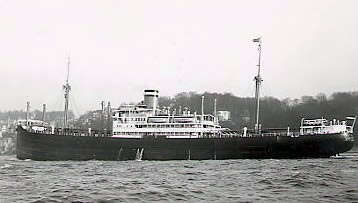
German Blockade Runner ss RHAKOTIS
Source ist "Bibliothek fur Zeitgeschichte, Stuttgart"
10. We carried on during the next week, the water ration being for one hour in the morning and 1 ½ hours at night, but on the 36th morning the water was up to the thwarts, and I was unable to do any further bailing. At 0830 on the 36th morning - 12th December -I suddenly heard the noise of an engine, which appeared to be very close to the lifeboat; at first I thought it must be an aircraft, but I was too weak even to hoist the red sails, so I burned a flare and shouted loudly. Immediately a voice answered me "All right". I then realized slowly that there was a ship very close to us, so I lay back in the lifeboat and waited. A few minutes later the ship came alongside, lowered a ladder and a seaman came down into the boat. He put a sling round each of us and we were hoisted on board. I thought it was an American ship, but on asking one of the crew I learned she was the German Blockade Runner, RHAKOTIS. Apparently she had been stopped for about 5 hours with engine trouble, and had just restarted her engines as we drifted by. We were taken straight to the Sick Bay and put to bed. The woman passenger was in a serious condition and continued to get weaker, the German Doctor told me that all the tissues in her throat had collapsed and she was unable to eat anything. She died on the 17th December and I was taken on deck to attend her burial on the 18th. The Quartermaster and I were kept in the Sick Bay for nearly three weeks before being allowed to walk. During this time the German Doctor was most attentive, visiting us three times a day. He kept us on a strict diet of milk and light food for 10 days, then gradually allowed us to eat the normal ship's food. My legs and thighs were very painful whilst in hospital, I had a number of soars on my legs, and my feet were blistered, the toes and nails having turned black.
11. After three weeks we were allowed to walk about the ship. I found there were also about 12 Norwegian seamen on board who had been rescued in the Indian Ocean and had been on board for about three months; they were being taken to Bordeaux to be repatriated and sent back to Norway. This German ship flew a number of flags, I particularly noticed that a Dutch flag was frequently flown forward. We were allowed to wander about the ship as we liked but whenever "action" stations were sounded we were shut up in the hold forward with the Norwegians. Every night U-boats would surface near the ship and on one occasion three submarines surfaced all at the same time; the RHAKOTIS stopped and orders were shouted to her through a megaphone.
12. At 0230 on New Year's morning the ship was suddenly lit up by flares and we were promptly sent below. I asked the Guard what was happening as I could hear machine gun fire. The Guard told me that the ship was being attacked by a single British aircraft, unfortunately, he said, the 'plane had got away undamaged. At 1500 on New Year's Day a British Warship opened fire on the ship. Again we were rushed below as the first shell struck amidships. Realizing the ship was going to be sunk, a German Marine Officer with 2 ratings dashed into the hold, driving us and the 12 Norwegians before them, just as we were about to make an effort to get up the ladder. They then mounted two machine guns, and trained them on us, with every intention of murdering the lot of us. Had it not been for the timely arrival of the Chief Officer, who kicked away the supports of the machine-guns, there is little doubt that we should not be alive to tell the tale. The Chief Officer informed the Marine that the Captain had ordered us to go on deck and to take our chance in the lifeboats with the rest of the crew. We went up to the boat deck with the Chief Officer, and saw that the shells were coming over very fast now. The two starboard lifeboats were lowered and I believe the crew in these two boats were rescued by a submarine later in the day. Angus MacDonald, the Quartermaster, was in one of these boats, and I understand this man is now a Prisoner of War in Germany. I remained with the German Chief Officer who abandoned the ship in one of the port lifeboats with 37 of the crew. He set a course for Spain, knowing it was not far away. The boat had plenty of food and water, I found the German biscuits were much softer than ours and much easier to eat, also instead of pemmican they had tins of bully beef which is much more palatable. Besides the usual water supply this lifeboat had a number of bottles of soda water. The German Officer did not take much trouble to ration the food as he expected to reach Spain within a few days. On the 5th January we were picked up by a Spanish fishing trawler which towed the boat to Corunna arriving at 1500 on the same day. The Captain's lifeboat had arrived on the 4th January. I had barely recovered from my first trip in a lifeboat, consequently I was feeling very weak and tired when I arrived at Corunna. The British Consul was informed that there were no English people in the lifeboat, and had not sent to meet me. However, on learning I was British he immediately came down and at 1930 took me to a hotel where I stayed for 5 days. Before being sent by rail to Madrid; from there I proceeded to Gibraltar, and finally returned to the United Kingdom.
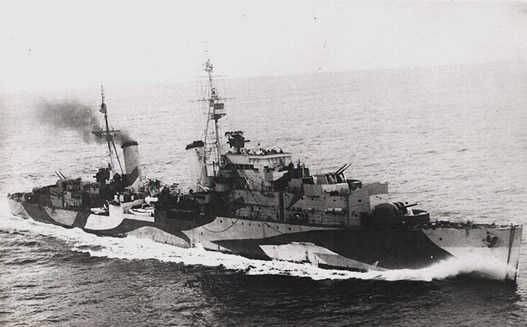
Courtesy of David Page
Dido class cruiser HMS SCYLLA
13. I think our pemmican is too strong and too salty, after a few days in the lifeboat quite a number of the men were unable to eat it. I also consider the biscuits are too hard, I found the only way to eat them was to soften them in water, making them into a thick paste with the pemmican. I think all lifeboats should have more sal volatile and iodine, we ran out of medical supplies long before we were rescued. I would also suggest that the water breakers and tanks should be clearly marked with their capacity in order to facilitate the rationing of the water. If it were possible I think lifeboat rations should be adjusted and changed according to the climate in which the ship happens to be sailing at the time.
14. I would like to specially mention the outstanding behaviour of Quartermaster Angus MacDonald. This man took full charge of the lifeboat after the death of Chief Officer Britt, and Captain MacCall. He was very experienced in small boats and took charge of the steering while I looked after the rations and kept the natives in order. Whilst in the lifeboat I kept a log of all the events but on being rescued by the s.s. RHAKOTIS this log was taken from me, in fact everything was stripped from our lifeboat and taken on board.
Please see an associated page: An account by Angus MacDonald Ordeal
